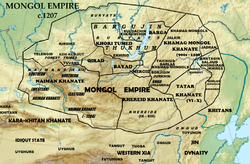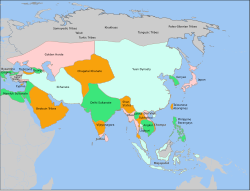World History empires name meanings study guide: Difference between revisions
| Line 93: | Line 93: | ||
|} | |} | ||
== | == Mongol empires == | ||
{| class="wikitable" | {| class="wikitable" | ||
!Name | !Name | ||
| Line 107: | Line 107: | ||
| | | | ||
|- | |- | ||
|Mongol Empire | | | ||
=== Mongol Empire === | |||
| | | | ||
* started by Genghis Khan or "Temüjin" | * started by Genghis Khan or "Temüjin" | ||
| Line 131: | Line 132: | ||
[[File:Asia in 1335.svg|thumb|Asia in 1335, showing the four "Khanates", successor empires to the Mongol Empire, often referred to as "fragments" of it.|alt=Relict states of the Mongol Empire|none|250x250px]] | [[File:Asia in 1335.svg|thumb|Asia in 1335, showing the four "Khanates", successor empires to the Mongol Empire, often referred to as "fragments" of it.|alt=Relict states of the Mongol Empire|none|250x250px]] | ||
|- | |- | ||
|Golden Horde (Mongol) | | | ||
=== Yuan Dynasty === | |||
|see above under China dynasties for Yuan | |||
| | |||
| | |||
| | |||
|- | |||
| | |||
=== Golden Horde (Mongol) === | |||
| | | | ||
*"Golden Horde" means "Great State" in Turkic. | *"Golden Horde" means "Great State" in Turkic. | ||
| Line 138: | Line 147: | ||
**so the Golden Horde was referred to by Europeans as "Tatars" | **so the Golden Horde was referred to by Europeans as "Tatars" | ||
*"Tatar" probably comes from persian for "mounted messenger" | *"Tatar" probably comes from persian for "mounted messenger" | ||
**"Tatar" came to refer to all the Turkic people in Russia | **"Tatar" came to refer to all the Turkic people in Russia | ||
**thus "tartar sauce", "steak tartare" | **thus "tartar sauce", "steak tartare" | ||
| | | | ||
| Line 149: | Line 158: | ||
|- | |- | ||
| | | | ||
=== Chagatai Khanate === | |||
| | | | ||
* named for the 2nd son of Ghengis Khan, Chagatai Khan | |||
* Chagatai was considered rebellious and refused to recognize Ghengis Khan's first son, Jochi, as his full brother (thus marking a weakness in such imperial arrangements that have different sons from different wives of an organizing ruler) | |||
* a Turkic language later developed in the region of Chagatai's rule, and was called "Chagatai"; the modern languages, Uzbek and Uyghur, a direct descendants of Chagatai | |||
|1242-1347 / | |||
1347-1487 | |||
| | | | ||
| | | | ||
* Chagatai inherited this region after the death of Genghis Khan in 1227; Chagatia died in 1242 | |||
* during reign of Kublai Khan (who started the Yuan Dynasty), Chagatai rulers broke away from his rule | |||
* Chagatai Khanate consists of modern Central Asian states | |||
* in 1347, the Khanate was divided when Moghulistan was declared independent under a tribal alliance led by Tughlugh Timur | |||
* Tughlugh Timur converted to Islam | |||
** over time, his successors were also Muslim and eventually imposed Sharia Law | |||
* in the 1400s the region underwent "Turkification," where by Turkic populations / culture largerly replaced Mongol culture adn/or Moghul populations | |||
|- | |- | ||
| | | | ||
Revision as of 16:14, 4 January 2023
Goal of this article is to help students identify context and historical recollection via definitions of historical names and terms
- along with memorizing names, places (map literacy) and dates
- historical knowledge and test-day recollection can be enhanced through etymology, or word origins of key historical places, empires or dynasties
China empires/ dynasties[edit | edit source]
| Name | Name definition | Dates | Region | Notes |
|---|---|---|---|---|
| Chinese dynasties follow four general categories of name origins: |
|
| ||
Yuan Dynasty[edit | edit source] |
|
1271–1368 |
| |
Ming Dynasty[edit | edit source] |
|
1368-1644 |
| |
Qing Dynasty[edit | edit source] |
|
1644–1911 | Manchuria, China |
|
Mongol empires[edit | edit source]
| Name | Name definition | Dates | Region | Notes |
|---|---|---|---|---|
Mongol Empire[edit | edit source] |
|
1206–1368 | Eurasia |

 |
Yuan Dynasty[edit | edit source] |
see above under China dynasties for Yuan | |||
Golden Horde (Mongol)[edit | edit source] |
|
| ||
Chagatai Khanate[edit | edit source] |
|
1242-1347 /
1347-1487 |
| |
Europe monarchies/ empires[edit | edit source]
India empires[edit | edit source]
| Name | Name definition | Dates | Region | Notes |
|---|---|---|---|---|
| Timurid Empire |
|
1370–1507 | Persia (Iran), central Aisa, northern India |
|
| Mughal Empire |
|
1526–1857 |
Middleastern empires[edit | edit source]
| Name | Name definition | Dates | Region | Notes |
|---|---|---|---|---|
| Ottoman Empire |
